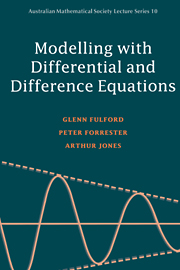Preface
Published online by Cambridge University Press: 05 June 2012
Summary
This book provides an introduction to modelling with both differential and difference equations. Our approach to mathematical modelling is to emphasize what is involved by looking at specific examples from a variety of disciplines. From each discipline enough background is provided to enable students to understand both the assumptions and the predictions of the models. Exercises have been included at the end of each section. They are intended to provide a balanced development of some of the main skills used in mathematical modelling, and hence they are an essential part of the book.
The main mathematical tools used in the book are differential and difference equations. Differential equations have their origins in mechanics: Newton's laws of motion lead to differential equations whose solutions can be used to predict the position of a body at some later time. Differential equations have been closely associated with the rise of physical science in previous centuries and they are now being used as models for real world problems in a variety of other disciplines. Difference equations are the discrete analogues of differential equations. They have risen to prominence in the last decade, during which it has become generally known that solutions of even very simple difference equations can exhibit complex chaotic behaviour.
To allow time for the development of other modelling skills besides solving the equations arising from the models, we have selected only models involving differential equations which are relatively easy to solve.
- Type
- Chapter
- Information
- Modelling with Differential and Difference Equations , pp. ix - xPublisher: Cambridge University PressPrint publication year: 1997

